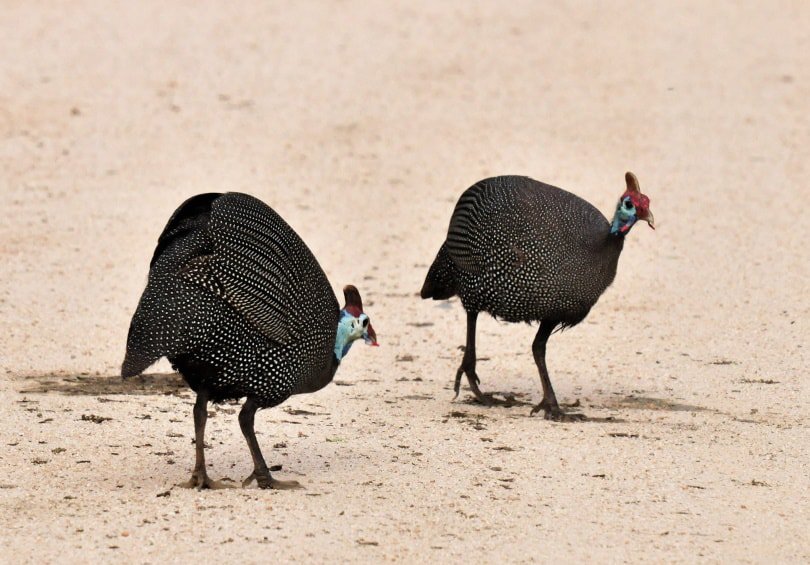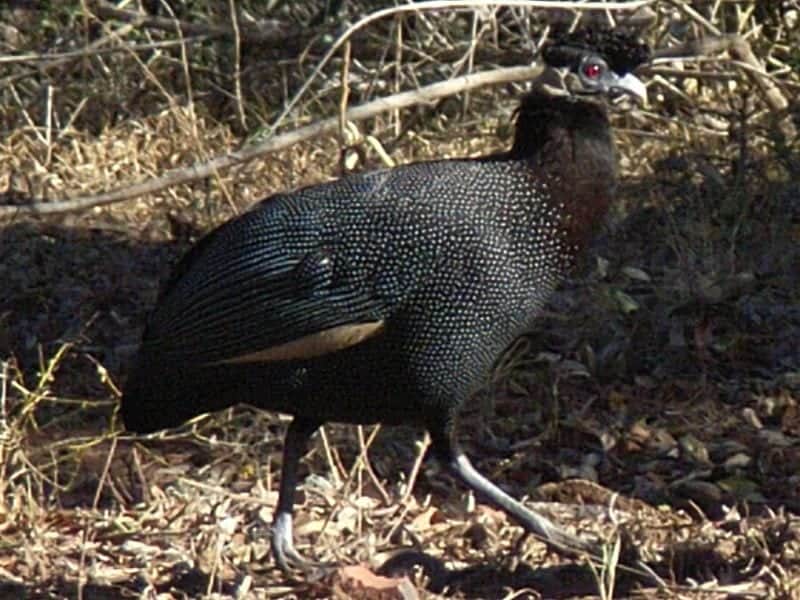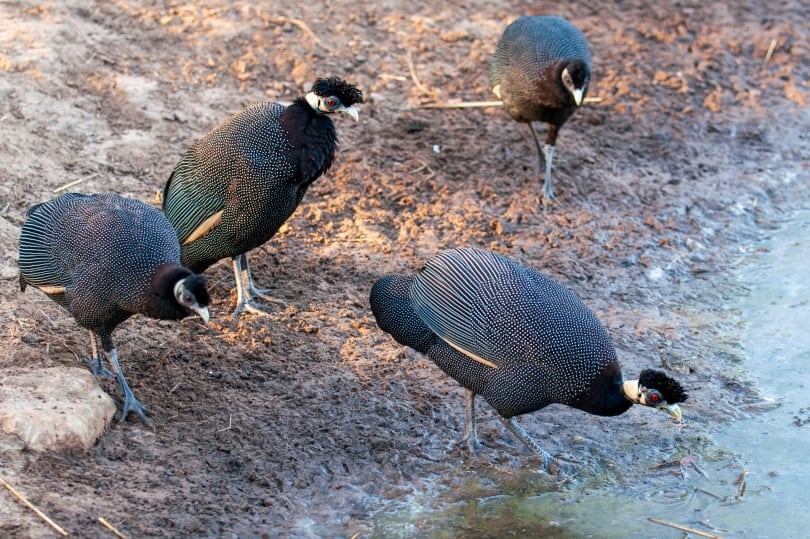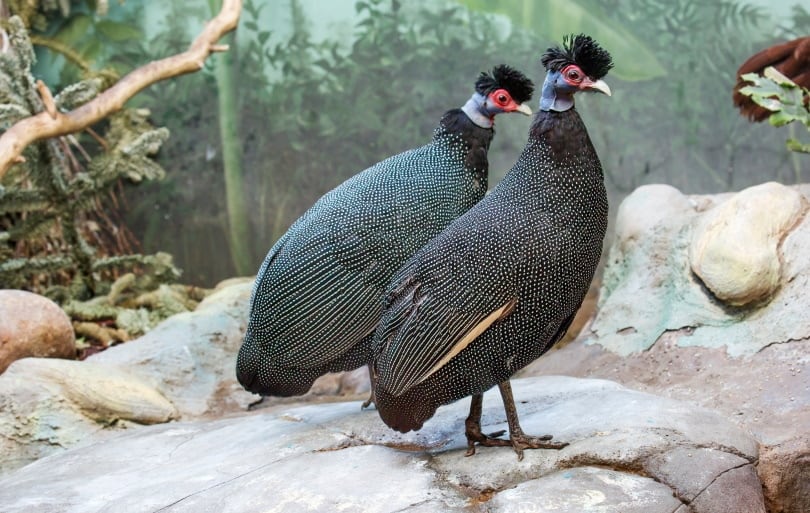The Crested Guinea Fowl is a bird species related to turkeys and pheasants, which have become popular due to their unique characteristics and behaviors. You can find them in sub-Saharan deserts, forests, farms, and even zoos. If you want to know about this unique, largely disease-free bird, read on to learn some facts about this interesting and unique-looking bird.

Quick Facts About The Crested Guinea Fowl
| Scientific Name: | Guttera pucherani |
| Place of Origin: | Africa |
| Uses: | Guards, pest control |
| Crested Guinea Fowl (Male) Size: | 4 pounds, 16 to 28 inches long |
| Female Size: | 3.5 to 4 pounds, 16 to 28 inches long |
| Color: | Black, bluish-white spots |
| Lifespan: | 12 to 15 years |
| Climate Tolerance: | Sub-Saharan deserts, forests, farms, domesticated places |
| Care Level: | Easy and low-maintenance |
| Production: | 100 eggs a year, per hen |
| Temperament: | Aggressive |
Crested Guinea Fowl Origins

These domesticated birds hail from Africa and are classified in the Numididae family. They are more related to birds than chickens, and they can fly, although they prefer to walk and run. When they fly, it is short-lived. They are ground-nesting birds and feed on insects, which makes for built-in pest control.
It’s believed that the Romans kept Guinea Fowl much in the same way farmers keep chickens today. Egyptians domesticated these birds around 1475 BC and then spread them to the Greeks around 400 BC. These birds reached the Romans around 70 AD but eventually died out. They were reintroduced around the middle ages. Today, they are still seen in the wild in Africa.

Crested Guinea Fowl Characteristics
These birds have long, round bodies and very long necks. Of all the other species of Guinea Fowl, the Crested is the most recognizable due to the curly set of feathers on top of the head. Both males and females have this unique feature.
The Crested Guinea Fowl is monogamous and has the same partner for life. A hen can lay 4 to 7 eggs that are incubated for roughly 23 days. The male does not come back to the nest until the eggs hatch. It is then the male assists the female in brooding and rearing the chicks.
The females may lay their eggs in a different nest prepared by a different female of the same species and then abandon the eggs once laid, leaving the other female to incubate them. This practice is called Intraspecific Brood Parasitism.
These birds roost in trees at night to protect themselves from predators. Their flight is strong and fast, however, they can only fly around 328 feet before landing. They will fly into trees to eat berries and fruit, and they also follow primates around to catch any dropped food.
These birds make for excellent security guards, as they will run off any intruder or someone they think isn’t supposed to be there by sounding off a loud alarm. They have been known to chase off their owners, too, which can be a drawback. They can also be bullies to your other livestock. And one more thing, they are loud. They have a loud squawk, and when one guinea fowl gets separated from the flock, it will squawk until it’s reunited.

Uses
These birds make for excellent guards on farms because they are territorial; they can also be extremely aggressive. They will chase off any intruder, or anything they feel doesn’t belong, and this can apply to its owner, too!
They also make for excellent pest control. Flocks can kill mice and small rats, as well as invasive or destructive insects without damaging flowers or vegetables. They will eat wood ticks, flies, grasshoppers, and crickets.
A hen can lay up to 100 eggs per year. The eggs are light brown, speckled, and have a rich flavor. The meat is lean and has few calories but offers high protein.
Appearance & Varieties
The Crested Guinea Fowl has a distinctive feature that separates it from other species of Guinea Fowl, and that’s the crest of black feathers atop its head that resembles a wig or toupee. It has black plumage with white dots all over the body.
They are one of the larger ground birds in South Africa, reaching between 16 and 28-inches long with a wingspan of 59 to 71 inches. They have long necks with a bare face and neck. A whitish-faint yellow patch covers the back of the neck, and they have distinctive red eyes.

Population, Distribution & Habitat
You can find the Crested Guinea Fowl in sub-Saharan Africa, where they live in savannas and semi-arid climates. You can also find them in forests and woodlands. There are roughly 10,000 guinea fowl in the wild. The Guinea Fowl International estimates there are roughly 14,500 guinea fowl farms in the United States.
They have no threats and are classified of least concern by the International Union for Conservation of Nature. These birds are all over the world and are domesticated in the United States. If so inclined, you can purchase keets from a breeder to raise if you want to add them to your farm.

Are Crested Guinea Fowl Good for Small-Scale Farming?
The Crested Guinea Fowl only need approximately 1 to 2 acres of land to roam, but preferably more. They do best in flocks and need plenty of space to roam. They will also get stressed and act out if kept in small numbers, so you’ll need no less than 14 guinea fowls to keep this unwanted behavior at bay.
In a nutshell, you can use the Guinea Fowl for small-scale farming, but you’ll need patience, as they need training to go into coops at night, as well as training to respect property boundaries. They’re easier to train if you start at a young age when they are keets.


Final Thoughts
The Crested Guinea Fowl is unique in both its appearance and behaviors. They can serve valuable purposes, such as keeping pests down to a minimum and sounding off alarms when needed, but they can be loud and boisterous, too.
If you’re thinking of adding the Crested Guinea Fowl to your land, be sure to have a flock of at least 14, and training them at a young age is your best bet to keep unwanted behaviors to a minimum.
Featured Image Credit: Galina Savina, Shutterstock
